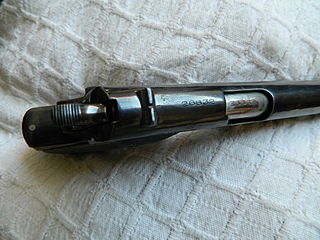
The American National Standards Institute is a private non-profit organization that oversees the development of voluntary consensus standards for products, services, processes, systems, and personnel in the United States. The organization also coordinates U.S. standards with international standards so that American products can be used worldwide.

The International Standard Book Number (ISBN) is a numeric commercial book identifier which is intended to be unique. Publishers purchase ISBNs from an affiliate of the International ISBN Agency.

A serial number is a unique identifier assigned incrementally or sequentially to an item, to uniquely identify it.
An Amazon Standard Identification Number (ASIN) is a 10-character alphanumeric unique identifier assigned by Amazon.com and its partners for product identification within the Amazon organization.
Han unification is an effort by the authors of Unicode and the Universal Character Set to map multiple character sets of the so-called CJK languages into a single set of unified characters. Han characters are a common feature of written Chinese (hanzi), Japanese (kanji), and Korean (hanja).
The National Drug Code (NDC) is a unique product identifier used in the United States for drugs intended for human use. The Drug Listing Act of 1972 requires registered drug establishments to provide the Food and Drug Administration (FDA) with a current list of all drugs manufactured, prepared, propagated, compounded, or processed by it for commercial distribution. Drug products are identified and reported using the NDC.

An International Standard Serial Number (ISSN) is an eight-digit serial number used to uniquely identify a serial publication, such as a magazine. The ISSN is especially helpful in distinguishing between serials with the same title. ISSN are used in ordering, cataloging, interlibrary loans, and other practices in connection with serial literature.
In marketing, a product is an object or system made available for consumer use; it is anything that can be offered to a market to satisfy the desire or need of a customer. In retailing, products are often referred to as merchandise, and in manufacturing, products are bought as raw materials and then sold as finished goods. A service is also regarded to as a type of product.
International Standard Musical Work Code (ISWC) is a unique identifier for musical works, similar to ISBN for books. It is adopted as international standard ISO 15707. The ISO subcommittee with responsibility for the standard is TC 46/SC 9.
The International Standard Recording Code (ISRC) is an international standard code for uniquely identifying sound recordings and music video recordings. The code was developed by the recording industry in conjunction with the ISO technical committee 46, subcommittee 9, which codified the standard as ISO 3901 in 1986, and updated it in 2001.

A geographical indication (GI) is a name or sign used on products which corresponds to a specific geographical location or origin. The use of a geographical indication, as a type of indication of source, may act as a certification that the product possesses certain qualities, is made according to traditional methods, or enjoys a certain reputation, due to its geographical origin.
Global Trade Item Number (GTIN) is an identifier for trade items, developed by GS1. Such identifiers are used to look up product information in a database which may belong to a retailer, manufacturer, collector, researcher, or other entity. The uniqueness and universality of the identifier is useful in establishing which product in one database corresponds to which product in another database, especially across organizational boundaries.

The International Article Number is a standard describing a barcode symbology and numbering system used in global trade to identify a specific retail product type, in a specific packaging configuration, from a specific manufacturer. The standard has been subsumed in the Global Trade Item Number standard from the GS1 organization; the same numbers can be referred to as GTINs and can be encoded in other barcode symbologies defined by GS1. EAN barcodes are used worldwide for lookup at retail point of sale, but can also be used as numbers for other purposes such as wholesale ordering or accounting.
ISO 639-6, Codes for the representation of names of languages — Part 6: Alpha-4 code for comprehensive coverage of language variants, was a proposed international standard in the ISO 639 series, developed by ISO/TC 37/SC 2. It contained four-letter codes that denote variants of languages and language families. This allowed one to differentiate between, for example, historical (glvx) versus revived (rvmx) Manx, while ISO 639-3 only includes glv for Manx.
ISBT 128 is a global standard for the identification, labeling, and information transfer of medical products of human origin across international borders and disparate health care systems.
Liv-ex is the global fine wine market. It provides trading, settlement and data services to wine merchants around the world.
Food or drink competitions reward products primarily for their "gustative worth" in the form of an award or a medal. These competitions can be classified into different categories, and most awards are product-specific, such as for wines, beers, and cheeses. Others focus on local, regional and/or national products. Finally, the international competitions test all kinds of foods and drinks available to consumers on a retail basis. Wine is probably the most tested drink, followed by beer and spirits.
The Health Industry Business Communications Council is the primary standard-setting and educational organization for healthcare bar coding.
The Legal Entity Identifier (LEI) is a 20-character, alpha-numeric code based on the ISO 17442 standard developed by the International Organization for Standardization (ISO). It connects to key reference information that enables clear and unique identification of legal entities participating in financial transactions. Each LEI contains information about an entity’s ownership structure and thus answers the questions of 'who is who’ and ‘who owns whom’. Simply put, the publicly available LEI data pool can be regarded as a global directory, which greatly enhances transparency in the global marketplace.
International Standard Number may refer to:







